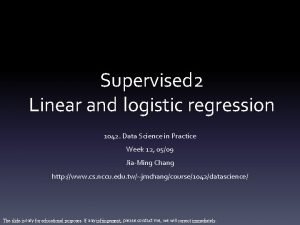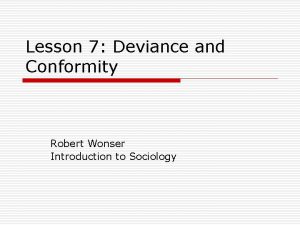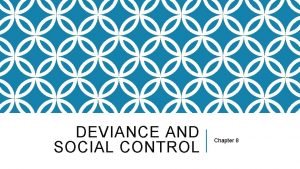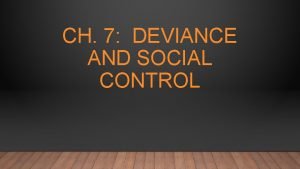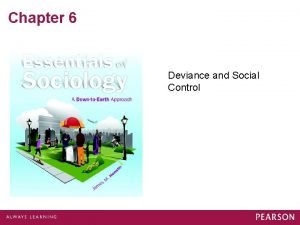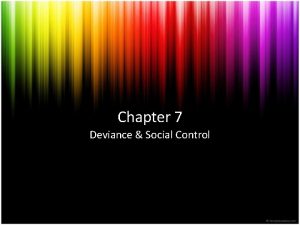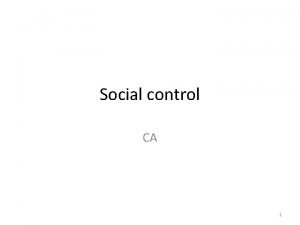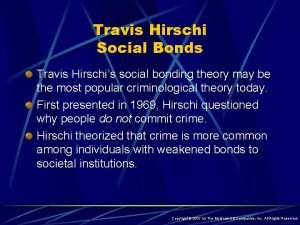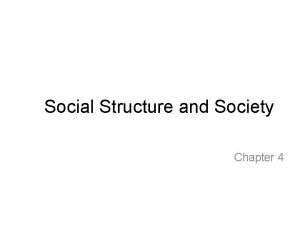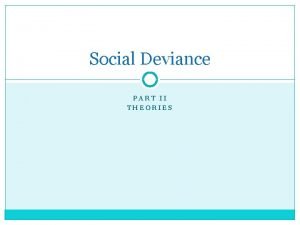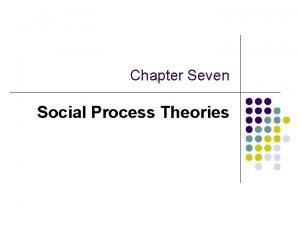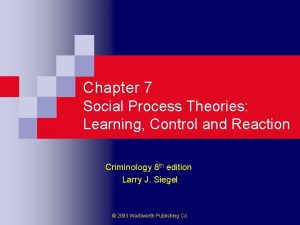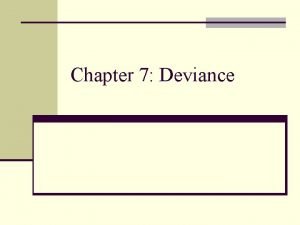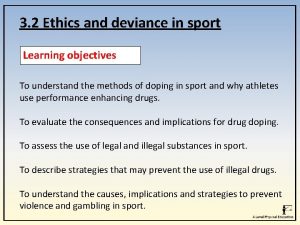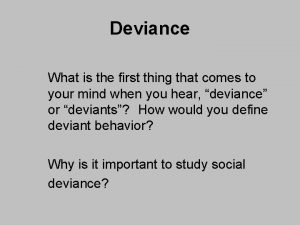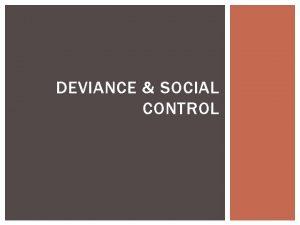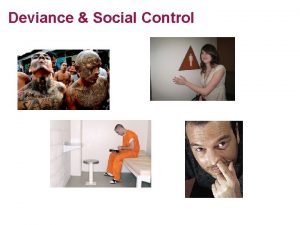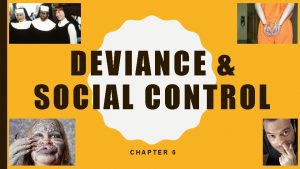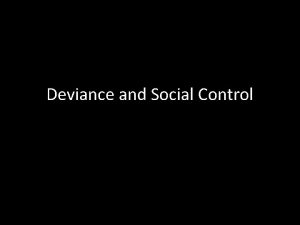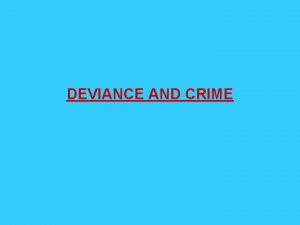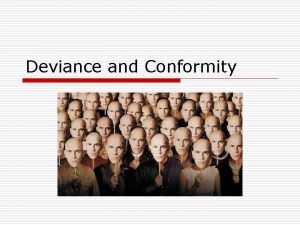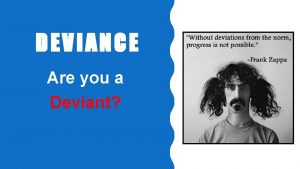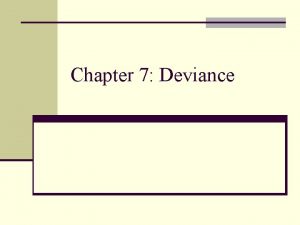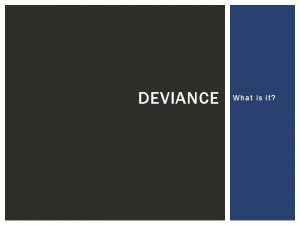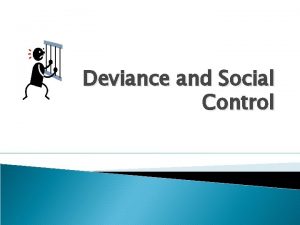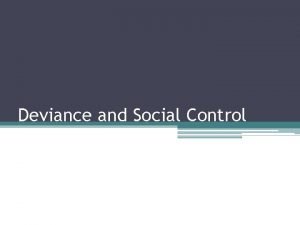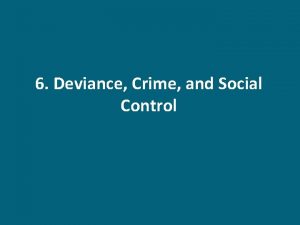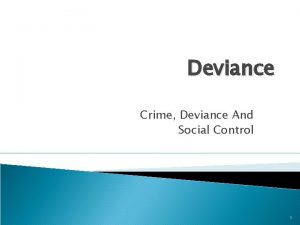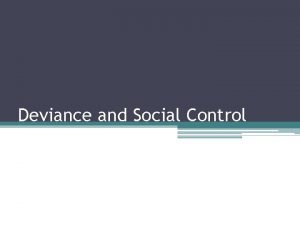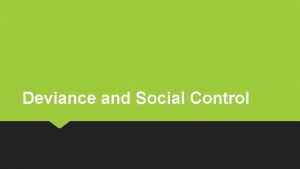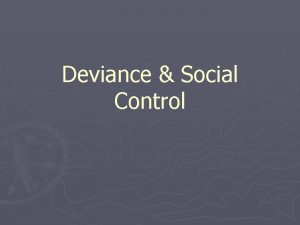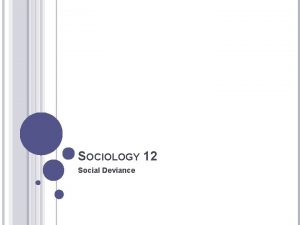Deviance and Social Control Ch 7 1 THE








































- Slides: 40

Deviance and Social Control Ch 7 1 – THE NATURE OF DEVIANCE

The Nature of Deviance �Deviance – behavior the departs from the social norm. �Deviant – person who significantly departs from the social norm

The Nature of Deviance �What are examples of behavior considered deviant in one group or culture but not another? �What are some examples of deviant behavior that is found in all groups or cultures? �What causes a person to be deviant?

Social Control �Social controls – ways to encourage or enforce conformity �Social sanctions – rewards and punishments to encourage conformity

Competing explanations of Deviance � Biological —a physical illness �Psychological — personality disorder � Sociological —socialization into deviance

Negative and Positive Deviance Negative Deviance -Based on ignoring or rejecting social norms -Extreme cases lead to anarchy Conformity -Normally Accepted Range of Behavior Positive Deviance based on unquestioned acceptance of norms - extreme cases leads to fascism

Functionalism and Deviance BASIC VIEWS NEGATIVE EFFECTS BENEFITS STRAIN THEORY CONTROL THEORY

Functionalism and Deviance – Negative Effects � Inconsistency leads to trust issues Ex. If people randomly decide not to come to work � Can cause more non- conforming behavior in others Ex. Teachers not coming to work could lead students to not coming to school, which leads to more kids on the street, which leads to more gang activity, etc… � Deviant behavior is expensive The more deviation there is, the more police is needed, the more jails must be built, etc. . .

Functionalism and Deviance – Positive Effects � Clarifies existing social norms If a high school player curses at an official during a game, society will punish that athlete (penalty, suspension, etc…) in order to show to everyone the normative behavior � Relieves pressure to conform Teenagers have pressure from many authority figures and by listening to “deviant” music or dressing differently can reduce that pressure � Can increase unity in the group Traitors can inspire feelings of nationalism, patriotism, etc… � Promotes social change Ending women’s suffrage Civil Rights Movement

Functionalism and Deviance �Imagine you must move (without researching) to live in Japan… �Would you exhibit deviant behavior? Why or why not? �Anomie – social condition when norms are weak, conflicting, or absent.

Functionalism and Deviance �Robert Merton’s Strain Theory Deviance is more likely when there is a gap between cultural goals and the ability to achieve those goals. � Examples of our cultural goals? � What are legitimate means of attaining those goals? �Conformity is when people accept both the means and the end goal.

Functionalism and Deviance - Strain Theory � Innovation – accepting the goal, but using illegal means to achieve it. � Ritualism – Rejects the goal, but continues using legitimate means � Retreatism – Rejects both the goal and the means. � Rebellion – rejects both success and the approved means to achieve it. Substitute new goals and means.

Functionalism and Deviance - Strain Theory Means Goals + Conformity + Innovation - Ritualism + Retreatism - Rebellion +/- +/` +

Functionalism and Deviance �Travis Hirschi’s Control Theory Deviance correlates to the strength of the bond between the individual and society � The stronger the bond is, the more conformity there is � People conform in order to “save face”

Elements of Social Bonds �Attachment Conformity strength of ties to things like family, school, friends, churches etc… How strong are your ties? �Commitment A stronger commitment to the goal will lead to stronger conformity Do you believe your hard work will pay off?

Elements of Social Bonds �Involvement Participation in approved activities leads to more conformity Is there a relationship between kids who participate in extracurricular activities and conformity? �Belief The stronger the belief in the norms and values of the culture, the stronger the conformity What incentives to people have to conform if these four elements of social bonds don’t exist?

How does this transaction relate to Control Theory and Anomie?

Symbolic Interactionism and Deviance DIFFERENTIAL ASSOCIATION THEORY LABELING THEORY

Symbolic Interactionism and Deviance � Differential Association Theory Focuses on how deviance is learned Some groups teach members to deviate from social norms while others teach conformity. � Can you think of any such organizations? � Factors: Ratio of deviant to nondeviant people you are in contact with � Are significant others deviant? � Age of exposure to deviance � Is this deviant behavior?

Symbolic Interactionism and Deviance �Labeling Theory Society creates deviance by calling people ‘deviant’ Which direction would a label of “scholar” or “smart” propel you? How about the label of “delinquent”? Labels open and close doors of opportunity How does this connect to Cooley’s “Looking Glass Self”?

� In each of the cases below: � Identify a label, which may be attached to the person as a result of their deviant behaviour. � Outline how a deviant career may develop by describing the possible consequences of the labelling for the person’s future life and relationships. � Suggest ways in which that person might avoid being labelled even after they have committed the deviant act. � A young woman who is caught shoplifting in Wal-Mart. � A teacher who publicly declares himself/herself to be gay. � A person who is temporarily admitted to a mental hospital as a result of a nervous breakdown. � An 18 -year-old man who gets arrested during a fight at a football match.

Symbolic Interactionism and Deviance �With an unmarried pregnancy, who is usually labeled the deviant?

What are the degrees of deviance? �Primary deviance – deviant behaviors occur, but it does not affect the person’s label for themselves or their lifestyle. How often do you violate a cultural norm? Do you view yourself as a deviant? Do prisoners view themselves as deviants? �Secondary Deviance as a lifestyle, way of life, or career; people primarily view themselves as deviant Examples?

Consequences of Labeling �Social stigma �Undesirable label used by others that deny full social acceptance How would a person freed from prison have a stigma? Unemployed? Handicapped? Immigrant?

Conflict Theory and Deviance VICTIM DISCOUNTING WHITE COLLAR CRIME

Conflict Theory �Conflict theory states that tensions and conflicts arise when resources, status, and power are unevenly distributed between groups in society, and that these conflicts become the engine for social change. In this context, power can be understood as control of material resources and accumulated wealth, control of politics and the institutions that make up society, and one's social status relative to others (determined not just by class but by race, gender, sexuality, culture, and religion, among other things).

Race, Ethnicity, and Crime � Minorities are given unequal treatment in the justice system. 43% of death row inmates are black. � In interracial murders, Blacks are 13 X more likely to be put on death row than white who murder Blacks. � Blacks make up 12% of the total US population � of those arrested: 72% white 25% black Does this reflect the TV image?

Race, Ethnicity, and Crime �Victim discounting – seeing minority interests are less valuable as the majority (or power) group. If the victim is less valuable, the crime is less serious, and the punishment is less severe.

White-Collar Crime �White-collar crime – job related crime committed by high status people. �Enron �Freddie Mac

White-Collar Crime �More than $100 million each year is laundered through banks by whitecollar criminals. 10 X more than robberies, larcenies, burglaries, and auto thefts combined. �For every murder: 2 people die from unsafe working conditions

Crime and Punishment MEASUREMENT OF CRIME JUVENILE CRIME APPROACHES TO CRIME CONTROL

Measurement of Crime �What is crime? �How is crime data collected and measured? �Uniform Crime Reports

Approaches to Crime Control �Criminal justice system The institutions responsible for enforcing formal social sanctions for crimes. �Deterrence Punishing so others will not commit the same crime i. e. The death penalty

Approaches to Crime Control �Retribution – criminals pay compensation for their crime ‘eye for eye’ or revenge �Incarceration – Going to jail

Approaches to Crime Control �Rehabilitation – Resocializing people who have committed crimes to socially acceptable behavior �Recidivism – Cycle of repeating criminal behavior Why? � Stigma, influence of other prisoners, biological influences

An Example of Overconfomity in Sports The Norms of the Sport Ethic �An athlete makes sacrifices for “the game” �An athlete strives for distinction �An athlete accepts risks and plays through pain �An athlete accepts no limits in the pursuit of possibilities

Why Do Athletes Engage in Deviant Overconformity? �Sports are so exhilarating and thrilling that athletes want to play, and they will do almost anything to continue to do so �Being selected by coaches and managers is more likely when athletes over conform to the sport ethic

Athletes Most Likely to Over-Conform to the Sport Ethic �Those who have low self-esteem or are so eager to be accepted by their peers in sport that they will make whatever sacrifices they think others want them to make �Those who see achievements in sport as their only way to get ahead, make themselves a name, and become important to the world

Social Processes in Elite Power & Performance Sports �Bond athletes in ways that normalize over conformity to the sport ethic �Separate athletes from the rest of the community while inspiring awe and admiration among community members �Lead athletes to develop HUBRIS – that is, a sense of arrogance, separateness, and superiority

 Pseudo r-square
Pseudo r-square Lesson quiz 7-1 deviance and social control
Lesson quiz 7-1 deviance and social control Chapter 7 deviance crime and social control
Chapter 7 deviance crime and social control Sociology chapter 8 deviance and social control
Sociology chapter 8 deviance and social control Social control and deviance guided reading section 1
Social control and deviance guided reading section 1 Chapter 6 deviance and social control
Chapter 6 deviance and social control Social deviance
Social deviance What is social deviance
What is social deviance Social bond theory travis hirschi
Social bond theory travis hirschi Social thinking and social influence in psychology
Social thinking and social influence in psychology Social thinking social influence social relations
Social thinking social influence social relations Crime and deviance sociology revision
Crime and deviance sociology revision Primary and secondary deviance
Primary and secondary deviance Differential association example
Differential association example Difference between crime and deviance
Difference between crime and deviance Primary deviance
Primary deviance Social process theories criminology
Social process theories criminology Involver behavior
Involver behavior Deviance in sport
Deviance in sport Primary and secondary deviance
Primary and secondary deviance Deviant acts examples
Deviant acts examples Crime and deviance definition
Crime and deviance definition Marxism crime and deviance
Marxism crime and deviance Dysfunctions of deviance
Dysfunctions of deviance Hát kết hợp bộ gõ cơ thể
Hát kết hợp bộ gõ cơ thể Frameset trong html5
Frameset trong html5 Bổ thể
Bổ thể Tỉ lệ cơ thể trẻ em
Tỉ lệ cơ thể trẻ em Chó sói
Chó sói Chụp tư thế worms-breton
Chụp tư thế worms-breton Hát lên người ơi
Hát lên người ơi Các môn thể thao bắt đầu bằng tiếng đua
Các môn thể thao bắt đầu bằng tiếng đua Thế nào là hệ số cao nhất
Thế nào là hệ số cao nhất Các châu lục và đại dương trên thế giới
Các châu lục và đại dương trên thế giới Cong thức tính động năng
Cong thức tính động năng Trời xanh đây là của chúng ta thể thơ
Trời xanh đây là của chúng ta thể thơ Mật thư tọa độ 5x5
Mật thư tọa độ 5x5 Làm thế nào để 102-1=99
Làm thế nào để 102-1=99 Phản ứng thế ankan
Phản ứng thế ankan Các châu lục và đại dương trên thế giới
Các châu lục và đại dương trên thế giới Thể thơ truyền thống
Thể thơ truyền thống
